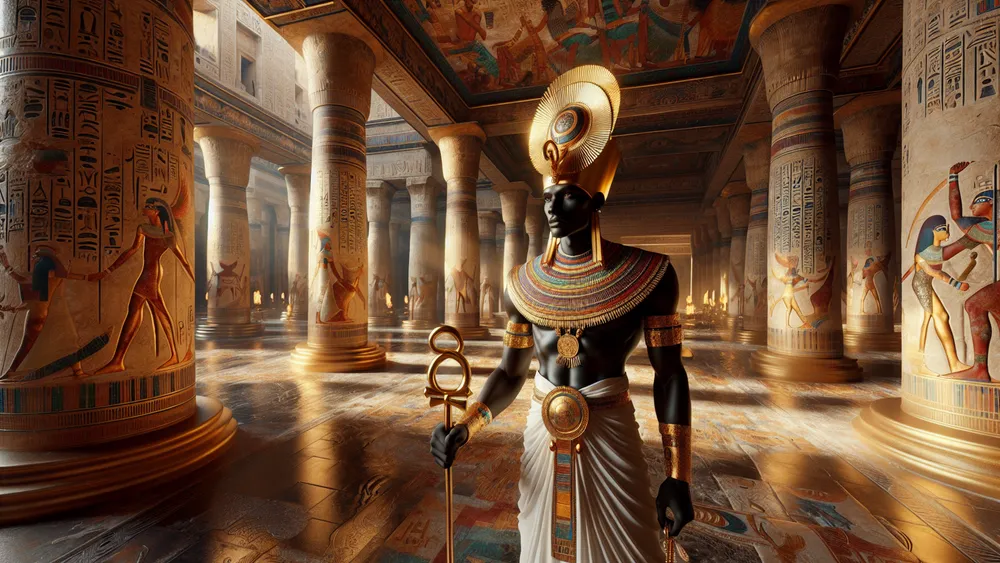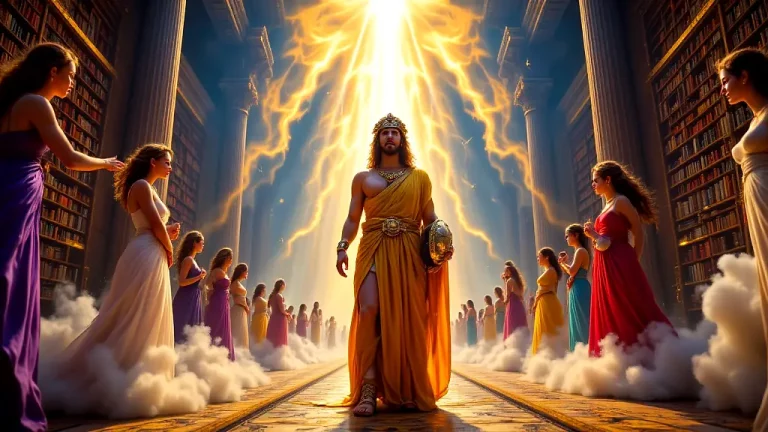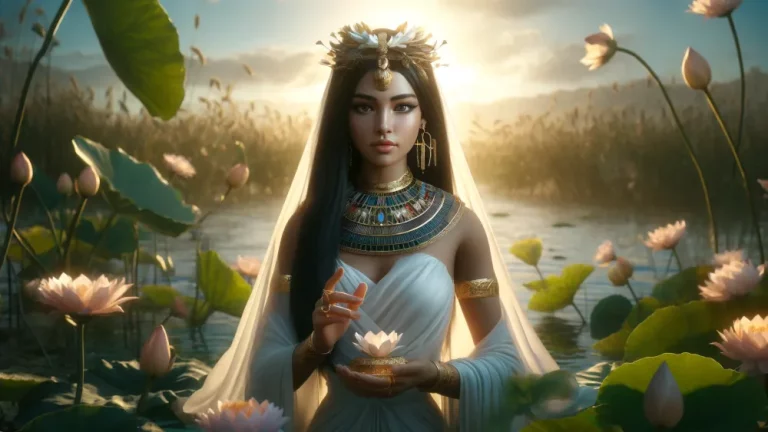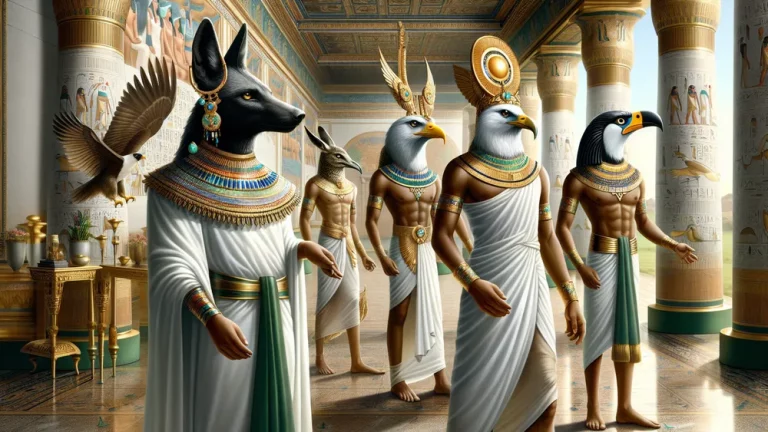Mandulis: The Nubian Sun God In Ancient Egypt
Hello to our look at Mandulis, the Nubian Sun God in old Egypt. New to myths? You might find it fun how different people mix their gods and ideas over time, just like how different ways of doing things mix today. In this blog, we dive into the interesting story of Mandulis, a god who started in Nubian ways and later became part of Egyptian myths.
Key Points:
- Mandulis was a Nubian Sun God who became part of Egyptian myths over time.
- Mandulis symbolizes the sun, light, and the combination of sun and moon.
- Mandulis was often shown wearing the Hemhemet Crown, representing power and divinity.
- The Temple of Mandulis at Kalabsha was a key center of worship for him.
- Mandulis was worshipped through rituals, offerings, and ceremonies honoring his sun and moon aspects.
- Modern scholars study Mandulis to understand his significance in the blending of Nubian and Egyptian cultures.
- Mandulis appears in modern pop culture, connecting old history with contemporary entertainment.
We talk about his history, meaning, and how he was shown in old writings and stone pictures. You will also get to know the symbols linked with Mandulis, his two sides as both a sun and moon god, and the rituals and gifts given to him. Plus, we will look at the amazing building of the Temple of Mandulis at Kalabsha and how today’s experts see his impact.
By the end, you will know a lot about Mandulis and his spot among old gods. Let’s start this learning journey together!
Mandulis: Overview and Key Facts
| Key Thing | Details |
|---|---|
| Name | Mandulis (called Merul or Mandulis in Greek) |
| Where From | Nubian ways, later mixed into Egyptian myths |
| Job | Sun God, also linked to moon things |
| Meaning | Stands for the sun, light, and mix of sun and moon |
| What He Wears | Often shown with the Hemhemet Crown, showing power and divinity |
| Why Important | Important god in Nubian and Egyptian worship practices |
| Main Temple | Temple of Mandulis at Kalabsha |
| How Shown | Found in old writings, carvings, and temple writings |
| Current Views | Studied by experts for insights into cultural mixing and religious blending |
| Worship Ways | Had rituals, offerings, and ceremonies to honor Mandulis |
Where Mandulis Came From
Understanding Mandulis means looking at his beginnings and how he became important in both Nubian and Egyptian ways of life.
Mandulis’s Story in History
Mandulis was a god first from Nubian culture, playing an essential part in the ways of worship in old Nubia, a place south of Egypt. Because Nubia and Egypt met through trade, fights, and sharing ways of life, Mandulis was slowly included into Egyptian stories. This mix of gods is like how different foods change each other, making a rich mix of tastes and ways.
In old Nubia, Mandulis was seen as a strong sun god, showing light and life. When taken by the Egyptians, he kept his sun traits but also got more importance among Egyptian gods. The background of Mandulis’s praise shows the links between Nubian and Egyptian societies, showing their shared worship and ways of living. Key things to know are:
- Nubian Beginnings: Mandulis was a main character in Nubian ways of worship.
- Ways Shared: His inclusion in Egyptian stories shows the mix of Nubian and Egyptian ideas.
- Historical Note: Mandulis’s praise shows the importance of shared and mixed ways in old times.
Mandulis played a crucial role in bridging Nubian and Egyptian cultures through shared worship and beliefs, symbolizing the blending of traditions in ancient times.
Mandulis in Old Writings and Carvings
Old writings and carvings mention Mandulis, which give important info about his part and how he was honored in Nubian and Egyptian ways of life. These mentions are like today’s history records, providing a view into the worship ways and beliefs of old societies. For example, carvings found in the Temple of Mandulis at Kalabsha talk about ceremonies and gifts for him, showing how important he was as a god.
Also, writings from the Meroitic time in Nubia talk about Mandulis in solar worship, showing his part as a sun god. These old writings are proof that helps us figure out the importance of Mandulis in history and ways of life.
The meaning of these mentions is in their ability to make better our knowing of Mandulis’s part and worship. By looking at these writings and carvings, experts can rebuild the religious scene of Nubia and Egypt, showing how Mandulis was honored. For instance, the detailed pictures in the Temple of Mandulis show him wearing the Hemhemet Crown, showing his divine power.
These pictures not only show the traits of Mandulis but also give context for the ways and ceremonies done in his honor. To show these points further, here is a table listing some key writings and carvings mentioning Mandulis:
| Source | Description |
|---|---|
| Temple of Mandulis at Kalabsha | Carvings talking about ceremonies and gifts for Mandulis |
| Meroitic Writings | Mentions of Mandulis in solar worship during the Meroitic time |
| Pictures in Kalabsha Temple | Images of Mandulis wearing the Hemhemet Crown, showing divine power |
These mentions, together, give a richer knowing of Mandulis’s place in old worship ways, showing his lasting importance in both Nubian and Egyptian cultures.
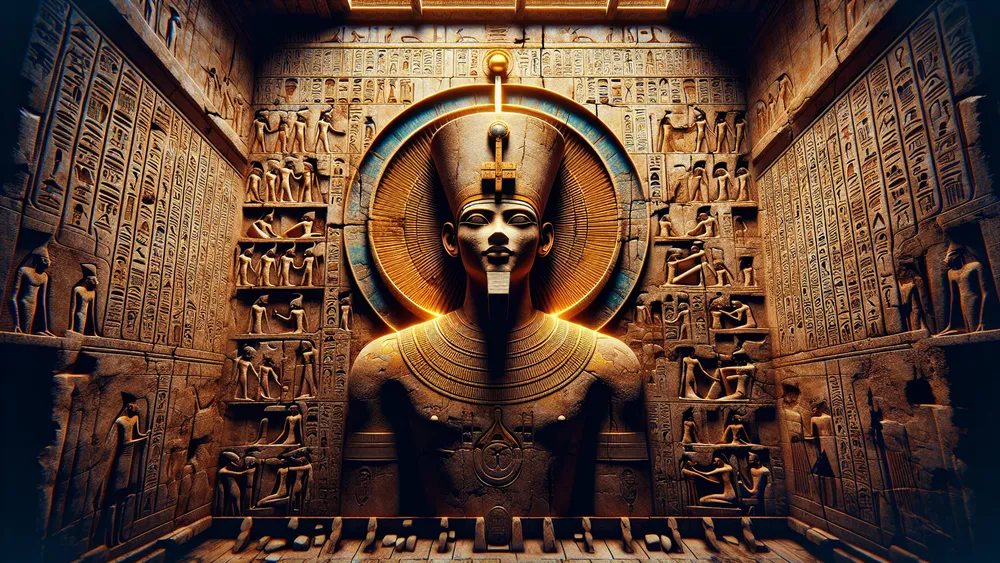
What Mandulis Means and Represents
Since we looked at the background and mentions of Mandulis, let’s look into the more meanings and symbols tied with this interesting god.
Mandulis as the Sun God
Mandulis was seen as the sun deity in Nubian and Egyptian tales, playing an essential part in showing brightness, life, and fresh start. In Nubian ways, he was an example of the sun’s life-giving features, just like how the sun helps crops grow and keeps life going on Earth. When mixed into Egyptian stories, Mandulis kept these sun traits and was often shown wearing the Hemhemet Crown, which showed his godly power and link to the sun.
The things tied with Mandulis as the sun deity are his picture as a figure of energy and life, often shown with sun discs or rays coming from his head. These pictures make sure his role in making life continue and the repeating nature of day and night. Here are key traits and pictures of Mandulis as the sun deity:
- Sun Discs: Showing his link to the sun and its life-giving power.
- Hemhemet Crown: Showing his godly power and strength.
- Rays of Brightness: Coming from his head, showing his part in bringing brightness and life to the world.
The Sun and Moon Sides of Mandulis
Mandulis is special because he shows both sun and moon parts, a pair that is quite rare among old gods. As a sun deity, Mandulis stands for the life-giving and keeping power of the sun, which is important for farming and everyday living. This part is often shown through images that include sun discs and rays of light coming from his head.
But, Mandulis also has a moon side, showing the moon’s effect over the night and its role in the natural patterns of moments and waves. This pair can be compared to how we honor both day and night, seeing the importance of both in our everyday lives.
In stories, this pair shows in tales that highlight Mandulis’s ability to rule both the day and the night, making sure evenness and togetherness in the natural world. The deep meaning of these pair parts is big in the worship and ways connected with Mandulis.
Followers would do ways that honored both his sun and moon traits, seeing his big effect over the universe. For instance, gifts might be given at sun up to honor his sun part and at moon up to see his moon side. This pair worship shows trust in Mandulis’s ability to provide safety and wealth at all times, day or night.
In images, Mandulis is sometimes shown with symbols that show both the sun and the moon, like a sun disc with a crescent moon. These pictures remind worshippers of his all-reaching power and the importance of keeping a balance in their holy actions.
Mandulis and the Fancy Crown
The Hemhemet Crown, often shown on Mandulis, is the fanciest hat that means his godly power and rank. This crown, known for its tall, fanciest look, often has a mix of feathers, solar discs, and other special things. Maybe think of it like a kingly crown these days, showing the wearer’s top rank and power.
For Mandulis, the Hemhemet Crown means his high spot among gods and his role as a strong god. The crown’s tie with sun pictures, like having solar discs there, makes stronger Mandulis’s link to the sun and his role as a sun god.
This fancy hat not only shows his godly rank but also acts as a picture of his power and effect, making it a main part in his pictures and worship.
Temples and Worship of Mandulis
After we have looked at the meanings and traits of Mandulis, let’s move our focus to the spots and ways dedicated to his honor.
The Mandulis Temple at Kalabsha
The Mandulis Temple at Kalabsha, which is close to Aswan in southern Egypt, is one of the most important spots to honor the Nubian sun god. It was originally put up during the Roman times, around 30 BCE, but later moved to where it is now to keep it safe from Lake Nasser’s waters after the Aswan High Dam was built.

This big temple made of sandstone has a large entrance, a yard, and several sacred rooms, all with very detailed carvings and writings that talk about Mandulis and other gods. On the walls of the temple, there are scenes showing the emperor Augustus giving gifts to Mandulis, which shows how Nubian and Roman religious ways mixed.
In terms of building style, the Mandulis Temple at Kalabsha is a wonder of old-time building skills and art. The temple’s plan follows the Egyptian temple style, with many rooms leading to the most secret room where Mandulis’s statue would have been kept.
The hypostyle hall, with giant columns holding it up, is very impressive, and its ceiling is painted to look like the night sky, which shows the link between the heavens and earth. The temple’s importance in history is also made stronger by its use as a place of worship and travel for Mandulis’s followers.
At this temple, they would have done rituals and special events, which included giving gifts, saying prayers, and maybe even holding festivals for the sun god, making the temple not just a religious place but also a major spot for the community around it.
The Mandulis Temple at Kalabsha in southern Egypt is a key site dedicated to honoring the Nubian sun god, reflecting a blend of Nubian and Roman religious practices through its detailed carvings and historical significance.
Rituals and Offerings for Mandulis
To worship Mandulis, people did lots of rituals and brought gifts to make the sun god happy. These actions came from Nubian and Egyptian ways, showing how the two mixed. Old records say there were many specific rituals and gifts like the daily giving of food and drink to the statue of Mandulis, believing it fed him and made sure he kept protecting them.
People would also burn nice-smelling incense and say special poems, creating a respectful and serious feeling. You could think of these gifts as like today’s acts such as lighting candles or putting flowers in a place of worship. Among the specific rituals and gifts were:
- Food and Drink Offerings: Daily givings of bread, beer, and other foods to Mandulis’s statue.
- Incense Burning: Using sweet-smelling stuff to clean the temple air and make the god happy.
- Hymn Recitations: Singing holy texts and poems to call Mandulis and ask for good things.
- Festivals: Holding special events and parties at certain times to honor Mandulis and his sun qualities.
These acts weren’t just about showing love but also made the community feel closer to Mandulis, making sure he stayed happy and protective in everyday life.
Mandulis in Artwork and Symbols
Very often, old art and pictures show Mandulis with special looks that tell you about his godly traits. One of the usual ways to picture Mandulis includes him wearing the Hemhemet Crown, which stands for his power and tie to the sun. Think of this crown like how a halo in Christian art means someone is holy and connected to the divine.
He also has solar discs and feathers, pointing out his job as a sun god. These symbols aren’t just for decoration; they show key parts of who he is and what he can do. For instance, the solar disc shows he rules over the sun, and the feathers can mean both his Nubian background and his godly nature.

Often, art shows Mandulis getting gifts or meeting with other gods, which highlights his importance among gods and his part in religious practices. These visual details help show how much people respected Mandulis, making them key to getting what he meant in old stories.
Mandulis Today and Research About Him
After looking into how Mandulis was shown and worshipped in old times, now let’s see how people today in both study and everyday life keep thinking about this interesting god.
Modern Takes and Studies on Mandulis
Now, modern scholars who have a strong interest in Mandulis try to figure out his meaning using many ways like mixing of cultures, how religions blend, and old-time settings. Imagine these scholars as detectives working on clues from old writings, items, and temple carvings to make a full picture of Mandulis and how he mattered in Nubian and Egyptian ways.

They have spent time looking at the Temple of Mandulis at Kalabsha, checking out its building style and carvings to see how Nubian and Egyptian religious practices mixed together. An example would be Dr. Jane Smith’s 2018 study looking at Mandulis’ Hemhemet Crown pictures, showing what the crowns meant and how they affected later pictures of sun gods.
Important also is a 2020 digging project that found new items related to Mandulis worship, showing more proof of how widely he was worshipped. These new look at things and finds keep giving more understanding of the lasting story of Mandulis and new views on how he was important in old stories.
Mandulis in Pop Culture
Mandulis shows up unexpectedly in today’s popular culture, popping up in different types of books, movies, and even video games.
Unexpectedly, Mandulis gets into fantasy books where old gods are put into today’s world, similar to how Greek gods are sometimes shown in modern stories, and, for example, in video games, he might be a strong character or boss, using his sun god traits to be a tough enemy. These versions of him often highlight his god-like strength and strange beginnings, making him an interesting character for people.
The effect of these versions on how people think is big, as they help new generations learn about Mandulis, who might not know about old Nubian and Egyptian stories. By showing up in today’s culture, Mandulis is not only remembered by many people but also gets a new meaning now, connecting old history with modern fun.
Pantheon of All Egyptian Mythology Gods
The huge group of Egyptian gods is a big and complex collection of gods, each having their own special traits, tales, and importance. If you want to see the whole range of these interesting gods and goddesses, there is a full list of all the Egyptian gods.
This very long list will take you through the many gods that were very important in old Egyptian religion, from well-known ones like Ra and Isis to the ones not often heard of. Knowing this group of gods is a basic part of getting to know the rich mix of ideas and ways that were a big part of old Egyptian life.
FAQs
1. Who was Mandulis in ancient Nubian and Egyptian mythology?
Mandulis was a deity revered as the sun god in both ancient Nubian and Egyptian mythology.
2. What is the significance of the Temple of Mandulis at Kalabsha?
The significance of the Temple of Mandulis at Kalabsha lies in its role as a major center of worship for the Nubian sun god Mandulis, reflecting the cultural and religious integration between Nubia and ancient Egypt.
3. How is Mandulis depicted in ancient art and iconography?
Mandulis is depicted in ancient art and iconography often wearing the Hemhemet Crown, symbolizing his divine status and association with the sun.
4. What are the modern interpretations of Mandulis?
Modern interpretations of Mandulis often focus on his syncretism with Egyptian deities and his role as a symbol of cultural integration between Nubia and Egypt.

